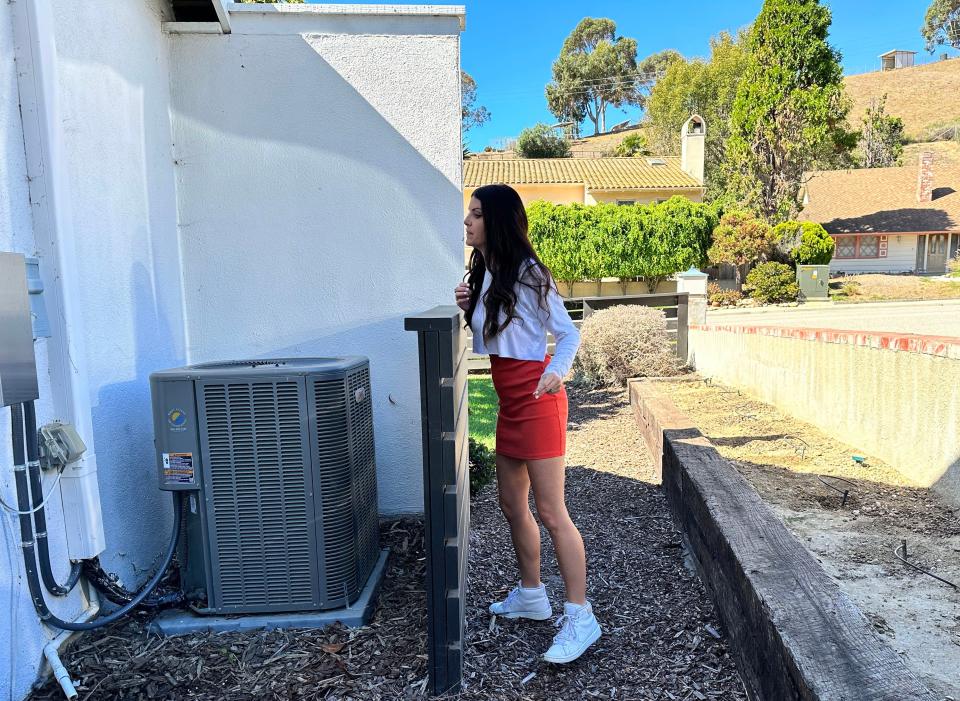When ocean breezes aren't enough: Air conditioning spreads as Ventura County heats up

Micaela Dritz grew up in Ojai and Oak View in the 1980s and 1990s. Her family never had air conditioning. She went to high school in Ventura, and nobody she knew there had it either. Every summer there would be a few uncomfortably hot days, and she’d go to the beach or Foster’s Freeze.
In 2010, she and her husband bought a home in a hillside neighborhood in Ventura, and almost immediately, she was struck by how hot it was inside: On warm summer days, it would hit 90 degrees upstairs. By the time they were ready to do some renovations in 2017, air conditioning was the first priority.
“The final push was, we just couldn’t sleep through the night,” Dritz said. “And we had a baby, and it was just too hot for the baby upstairs.”
The Dritz family was the first one on the street to install air conditioning. In the past six years, houses all over the neighborhood have followed suit.
So, too, have homes and businesses all over Ventura County, especially in Oxnard, Ventura and other coastal areas, where air conditioning was rare until about a decade ago. It's now standard in new construction, and heating and air conditioning companies say they’re doing brisk business adding air conditioning to existing homes, businesses, schools and other buildings.
“It’s just such a common amenity now. Everything will have it going forward,” said Nico Arguelles, the general manager of Oxnard-based Pacific Aire.
The increased demand for residential air conditioning is the main reason Pacific Aire’s overall business has been growing by about 30% per year, Arguelles said.
At West Coast Air Conditioning, also based in Oxnard, the residential air conditioning department started in 2017 with three employees and now has about 20, said Ben Hummer, West Coast’s residential manager.
“You used to get made fun of, being an air conditioning contractor out here in the 70-degree capital of the world,” Hummer said.
Air conditioning is growing in popularity in Ventura, Oxnard, Port Hueneme and Camarillo because the 70-degree capital of the world is seeing more 80-degree and 90-degree days than ever before. According to data from the National Weather Service, between 2015 and 2022, Oxnard averaged 27 days each year with high temperatures at 85 or above. Between 1982 and 2014, the average was 10 days per year at or above 85 degrees.
The entire planet is warming, but there are signs Ventura County is warming faster than most places. In 2019, the Washington Post published a study of the temperature change in every county in the continental United States between 1895 and 2018. Ventura County was the fastest warming county in the nation in that period; the county's average temperature went up 4.7 degrees Fahrenheit.
Temperatures are expected to continue rising. According to an analysis published by Vox in 2018, the average summertime high temperature in Oxnard was 76.1 degrees in 2000 and will hit 78.7 degrees by 2050. Ventura was projected to go from an average summertime high of 79.3 degrees in 2000 to 82.5 by 2050. Those projections assume that the world continues to burn fossil fuels at about the same rate it is now.
In Ventura, a 90-degree day was once quite rare, occurring about seven times a year in the 1980s, according to a data analysis performed for The Star by ClimateCheck, a company that provides climate risk data to the public and private sectors. The frequency of 90-degree days in Ventura has about doubled since then, and in a few decades more they'll be relatively unremarkable: ClimateCheck projects 20 or more days per year with 90-degree high temperatures by 2055.

'We're not getting that nighttime cooling anymore'
Even if fossil fuels become obsolete in the coming decades and the planet's carbon output drops significantly, temperatures are still projected to rise, by smaller amounts. And it won't take any additional warming to turn West Ventura County into air conditioning country.
The tipping of temperate regions like Ventura and Oxnard into places where it's hot enough for air conditioning is "one of the more subtle aspects of our changing climate," said Sean Anderson, a professor of environmental science and resource management at CSU Channel Islands.
There are factors other than just the high temperature in the summer, he said. We're also seeing higher overnight low temperatures, and that makes it harder to cool a house off by leaving the windows open at night.
"We're not getting that nighttime cooling anymore, and the other thing that's changed is the extended duration of the heat waves," Anderson said. "Maybe people can handle it being hot as hell for two weeks, but when that two weeks becomes six or eight weeks, they say, 'Screw this. I'm putting in air conditioning.'"
Cities and other local government agencies don’t track air conditioning installations because the permit they require is the same type that’s necessary for a new or replacement heater. But city officials in both Ventura and Oxnard said they're seeing far more air conditioning installations than just a decade ago.
Between the 2013-14 fiscal year and 2022-23, the city of Oxnard averaged 292 “mechanical application” permits per year, which covers new and replacement air conditioning and heating systems. In the decade before that, the city averaged 144 per year, less than half as many.
The increase was clearly due to more air conditioning, said Jessica Smith, a permit coordinator with the city. At least half of the city’s permit applications now include air conditioning, she said.
“Prior to about 2010, I never saw an air conditioning permit, ever,” Smith said. “It went from something I wouldn't ever process to something we see on a regular basis.”

Paying 5 figures for comfort
The changing climate isn't the only thing driving the increased demand for home air conditioning. Arguelles said the big spike in demand at Pacific Aire started about three years ago and seems related to government incentives to buy heat pumps, a type of all-electric heating and air conditioning system that operates with greater energy efficiency than traditional air conditioning.
Heat pump systems now account for almost half of Pacific Aire's installations, Arguelles said, and the company's heat pump jobs nearly tripled between 2020 and 2022.
The irony of air conditioning is that people need to use it more due to climate change, but using it more contributes to making climate change even worse. Heat pumps are the most environmentally friendly option because they use less power and therefore produce fewer carbon emissions. They can also be entirely carbon-free if they're installed on homes with solar panels or connected to an electrical grid that uses only green power.
At West Coast Air, business also started booming in 2020. Hummer attributes that to the pandemic and people spending a lot more time in homes without air conditioning.
"Everybody sat home during the day, locked in together, losing their minds," he said.
A new central air conditioning system for a home typically costs between $15,000 and $25,000, Arguelles said. A ductless system with wall-mounted "mini splits" might be between $5,000 and $15,000, he said, depending on the size of the home and the number of units needed.
Portable, plug-in air conditioners and window units are also becoming more popular in Ventura County, and those can be had for a little as a few hundred dollars and installed by the homeowner.
There are methods other than air conditioning to deal with the heat. Older homes in Ventura County were often built without any insulation. Arguelles said attic insulation is a very common home improvement and "can really change your indoor climate."
Both Arguelles and Hummer said they think the rising real estate costs in Ventura County are contributing to the spread of air conditioning. New buyers have more money to spend on renovations and higher expectations for comfort.
"If your house costs a million or $2 million, you probably want some climate control with it," Arguelles said.
Not cool enough for school
Things have changed so much, and so quickly, that some Ventura County schools had to start declaring "heat days" and canceling classes or dismissing students early.
The Oxnard High School District, which covers Oxnard, Port Hueneme and Camarillo, started declaring heat days in 2015, said Tom McCoy, the district's superintendent. There were about seven to 10 days each year in which school got out early due to the heat, until the district starting adding air conditioning in its schools.
Every school in the district now has air conditioning except for Channel Islands High School, where the work to add it is still underway, McCoy said.
The district has spent about $120 million adding air conditioning to its seven high schools, McCoy said, drawing the funding from a $350 million bond measure approved by voters in 2018. Four of the seven schools were built in the 1950s and 1960s, but even the newer campuses, including one built in 2015, didn't have air conditioning.
There was no doubt, though, that the district's eighth campus, Del Sol High School in Oxnard, would have air conditioning when it opened this year.
"We never had to really discuss it," McCoy said. "The new school was designed with the system from the start."
Tony Biasotti is an investigative and watchdog reporter for the Ventura County Star. Reach him at tbiasotti@vcstar.com. This story was made possible by a grant from the Ventura County Community Foundation's Fund to Support Local Journalism.
This article originally appeared on Ventura County Star: Ventura County coastal cities add air conditioning as temps increase

